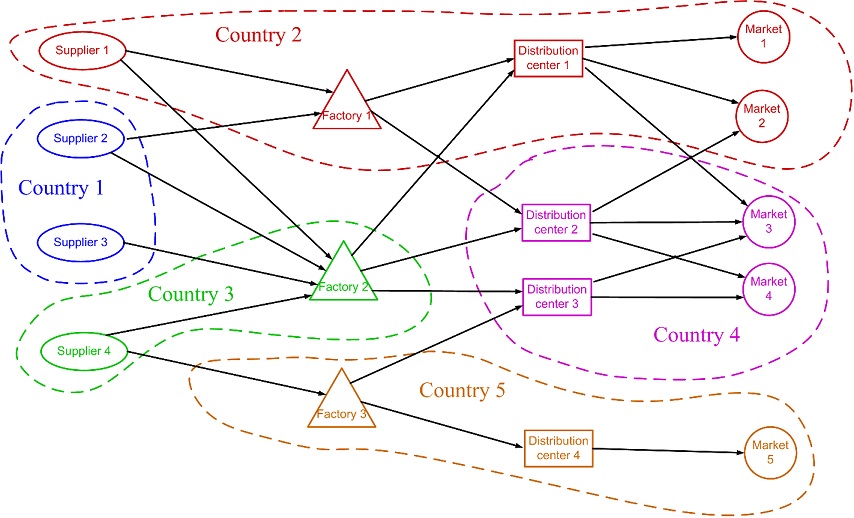The software product is intended for enterprises with subsidiaries in different countries or in zones with different tax laws.
A Global Supply chain Example within one enterprise is presented below.

In spite of the current regulations imposed by most countries to avoid arbitrary manipulation of transfer prices, there exist significant opportunity for profit maximization that is within the rule of law. It is mathematically proven that small changes in transfer prices have tremendous impact on the revenues of a multinational company.
The task of establishing optimal transfer prices cannot be solved independently from finding the optimal flow of goods since both affect the financial outcome. The result that is obtained through optimization of transfer prices with fixed flow of goods can be significantly improved if we are to manipulate flow of goods and identify transfer prices for each option. In fact, global optimal result can only be found with simultaneous optimization by both parameters – flow of goods and transfer prices.
Current optimizers in popular SCM systems (including SAP APO) utilize methods of Linear Programming (LP), Mixed Integer Linear Programming (MILP), and various heuristic methods. Methods of Nonlinear Programming and Mixed Integer Nonlinear Programming (MINLP) are utilized only for oil refining and chemical industries for planning refinery processes.
Utilization of only Linear Programming methods and Linear Mathematical Models in the widespread systems, limits the optimization spectrum to a single group of parameters, such as a transportation costs, volume of cargo transportation, production or transport capacity utilization, length of transport routes, etc. These systems lack the possibility of deeper optimization (through pricing variation) and hence the possibility of additional revenue. Although, in theory, targeted parameters could be cost, revenue, NPV, NCF, risk, flexibility, and level of customer service, in the majority of implemented systems a cost minimization of storage, transportation, and manufacturing is targeted.
Besides the products that offer optimization of logistics within supply chains, there are also products, which are commonly used by multinational corporations, that optimize taxes. These products solve the mathematical problem of Optimizing Revenue for Multinational Corporation through variation in transfer prices. However, the optimization is based solely on changing transfer prices while keeping the flow of goods constant. Thereby, these products only solve a linear problem and not the problem of quadratic programming.
In practice, optimization is carried out in two steps using the above products. Initially, the flow of goods is optimized by one of the APS systems and only then the transfer prices are optimized with one of the tax optimization products. Results of such optimization are far from true optimum, which can be achieved by solving a problem of quadratic programming.
According to test results, the more complicated the initial supply chain (a large number of points and lots of products to move), the more different the obtained result (calculated by sequential linear optimization tasks ) from global optimum. For supply chains with mid size complexity (150 of points, up to 50 products), revenue that is obtained through global optimum is 4% higher.
On the basis of common supply chain model, our product forms the most optimal flow of goods and establishes transfer prices at the same time. Contrary to traditional Linear Mathematical Model, our product utilizes Model of Quadratic Programming. It ensures maximization of profit lies within the limits of legislation for multinational companies with subsidiaries in different countries or zones with different tax laws.
New mathematical model and new numerical method allows to shift from optimizing logistic parameters and costs to optimizing revenues. There is no need in any additional data.
The product acts as add-on to SAP APO and utilizes data from SAP ERP. Mathematical model gets formed on ultra fast SAP HANA platform. The most important component of our optimization solution is highly parallel algorithm for solving quadratic programming equations, which splits the task and distributes it between thousands of Hadoop nodes.